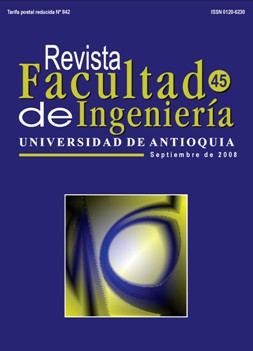Oscillation Control in a Synchronous Machine using a Neural based PSS
DOI:
https://doi.org/10.17533/udea.redin.18118Keywords:
Power system stabilizer, neural nets, synchronous machineAbstract
This paper presents the methodological design and the laboratory test of neural net based power system stabilizer (PSS). The architecture of the proposed PSS uses two neural networks, one neural based controller which is used to generate a supplementary control signal to the excitation system, and an additional neural net used to improve the performance of the neural based controller. In order to guarantee the correct operation of the proposed PSS, it is trained by using data obtained from several machine operating conditions and a variety of disturbances. The effectiveness is demonstrated by testing the proposed approach in a real synchronous machine in a laboratory facility.
Downloads
References
K. S. Narendra, K. Parthasarathy. “Identification and control of dynamical systems using neural networks”. IEEE Trans. Neural Networks. Vol. 1. 1990. pp. 4-27. DOI: https://doi.org/10.1109/72.80202
P. Shamsollahi, O. P. Malik. “Direct Neural Adaptive Control to synchronous generator”. IEEE Trans. On energy conversion. Vol. 14. 1999. pp. 1341–1346. DOI: https://doi.org/10.1109/60.815070
P. Shamsollahi, O. P. Malik. “Application of neural adaptive power system stabilizer in a multi-machine power system”. IEEE Trans. On energy conversion. Vol 14. 1999. pp. 731–736. DOI: https://doi.org/10.1109/60.790943
P. Shamsollahi, O. P. Malik. “Real-time implemen¬tation and experimental studies of a neural adaptive power system stabilizer”. IEEE Trans. On energy con¬version. Vol. 14. 1999. pp. 737 – 742. DOI: https://doi.org/10.1109/60.790944
W. Liu, G. Venayagamoorthy, D. Wunsch. “Adaptive neural network based power system stabilizer design”. IEEE Trans. On energy conversion. 2003. pp. 2970–2975.
K. Prabha. Power System Stability and Control. New York: McGraw-Hill, 1994.
S. Pérez, J. Mora, G. Olguin. “Maintaining voltage profiles using an adaptive PSS”. Transmission & Dis-tribution Conference and Exposition: Latin America, 2006. TDC apos. 06. IEEE/PES Volume 1. 2006. pp. 1–5. DOI: https://doi.org/10.1109/TDCLA.2006.311429
P. Shamsollahi, O. P. Malik, “On-line identification of synchronous generator using neural networs,” in Proc. Can. Conf. Elect. Comput. Eng.1996. pp. 595-598.
R. Wankeue, I. Kanwa, X. Dai-Do, A. Keyhani. “Iteratively reweighted least square for maximum likeliho¬od identification of synchronous machine parameters from on line tests”. IEEE Trans. Energy Conversion. Vol. 14. 1999. pp.159-166. DOI: https://doi.org/10.1109/60.766971
G. Goodwin, K. Sang. Adaptive filtering predic¬tion and control. Prentice – Hall. New Jersey. 1984. pp.125-134.
S. Pérez. Control de Oscilaciones de la Máquina Síncrona utilizando un Estabilizador Neuronal. M.Sc thesis, Universidad Tecnológica de Pereira, Pereira, Risaralda, Colombia, 2005. pp. 12-86.
Downloads
Published
How to Cite
Issue
Section
License
Revista Facultad de Ingeniería, Universidad de Antioquia is licensed under the Creative Commons Attribution BY-NC-SA 4.0 license. https://creativecommons.org/licenses/by-nc-sa/4.0/deed.en
You are free to:
Share — copy and redistribute the material in any medium or format
Adapt — remix, transform, and build upon the material
Under the following terms:
Attribution — You must give appropriate credit, provide a link to the license, and indicate if changes were made. You may do so in any reasonable manner, but not in any way that suggests the licensor endorses you or your use.
NonCommercial — You may not use the material for commercial purposes.
ShareAlike — If you remix, transform, or build upon the material, you must distribute your contributions under the same license as the original.
The material published in the journal can be distributed, copied and exhibited by third parties if the respective credits are given to the journal. No commercial benefit can be obtained and derivative works must be under the same license terms as the original work.










 Twitter
Twitter